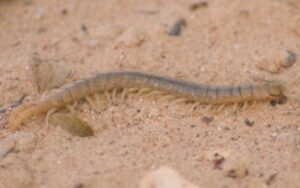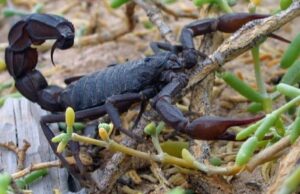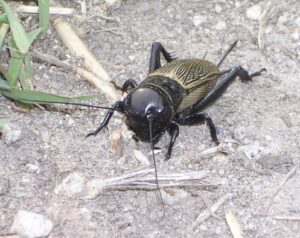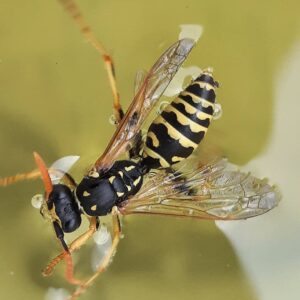Centipedes:
A – Forty-Four-Legged Lady
General Description
| · The forty-four-legged lady vary considerably in coloration and size.
· colopendra centipedes are large centipedes and vary in coloration and size. · It is the largest species found in tropical climates can exceed 30 cm and are the largest living centipedes in the world. |

Credit: P. Roosenschoon, DDCR |
- It has a drab coloration combining shades of brown and light brown.
- It has an elongated body with one pair of legs attached to most of the body segments. It differs from millipedes in that millipedes have two pairs of legs on most segments and bodies that are not flattened.
- Centipedes have a flattened, segmented body, long antennae, and many legs. This species has 19 segments (most individuals have 15). Each body segment has a pair of legs, and it regenerate legs if it is cut off. The last pair of legs is modified to have pincers, mainly to defend them from other predators.
- Centipedes have a pair of poison claws behind the head and use their poison to paralyze prey, usually small insects. However, the jaws of centipedes are weak and can only rarely penetrate human skin.
- The body is divided into two parts, the head, and a segmented trunk. They breathe through spiracles, holes positioned along the side of the abdomen, easily seen as black dots.
Life Cycle and Common Characteristics
- Egg laying occurs in spring and summer and the breeding usually takes place in late winter and early spring.
- Eggs (10-15 at a time) are laid singly in holes in the soil; the female fills the hole in on the egg and leaves it. The surface of the egg is covered with a sticky film to which soil particles adhere to form a protective layer.
- Centipedes overwinter as adults where there is adequate shelter within their immediate environment.
- Scolopendra centipede can be found in wood piles, baseboards of wooden fences, beneath ornamental bark, or baseboards of wooden fences.
- They usually live outdoors in damp areas, such as under leaves, stones, boards, or tree bark, or in mulch around outdoor plantings.
- If provoked, larger centipedes may bite, causing some pain and slight swelling. These “bites” are not caused by their jaws or mouthparts – rather,
- it’s their front legs, which are modified to look and function like jaws, that contain the venom glands.
- Scolopendra are predators of other arthropods and small vertebrates. The first pair of legs (“toxognaths”) in the scolopendrids are specialized for injecting venom. Larger individuals have been observed preying on frogs, lizards, birds, snakes, rodents, and even bats.
- Centipede sex does not involve copulation. Males deposit a spermatophore for the female to take up. In one case, this spermatophore is deposited in a web, and the male undertakes a courtship dance to encourage the female to engulf his sperm. In other cases, the males just leave them for the females to find.
Damages and Economic & Medical Implications
- Scolopendra do not damage household furnishings or food supplies.
- They are beneficial; they feed on insects, spiders, and other arthropods.
- Most people consider them a nuisance when they wander indoors.
- Smaller species are not large enough to penetrate human skin, and their bites are not serious (but an antiseptic should be used on the wound).
- The venom is not medically significant for most species of the genus The bites from several species can cause intense and long-lasting pain and swelling.
- The venom of certain species contains compounds such as serotonin, haemolytic phospholipase, a cardiotoxic protein, and cytolysin.
B – House Centipede
General Description
| · The body of this centipede is only 2.5-3.5 cm long, but with its 15 pairs of delicate, long legs make it seem much larger (7.5-10.0 cm long).
· The body is grayish-yellow with three dark stripes extending along the full length of the back.
|

Credit: Filip.vidinovski |
- The delicate legs enable it to reach surprising speeds of up to 0.4 meters per second running across floors, up walls, and along ceilings.
- House centipede has developed automimicryin that its tail-like hind legs present the appearance of antennae.
- Unlike most other centipedes, house centipedes have well-developed faceted eyes.
Life Cycle and Common Characteristics
- Unlike other centipedes, this species lives its entire life inside a building.
- In homes, they prefer to live in damp and undisturbed areas, such as cellars, closets, bathrooms, attics, and unexcavated areas under the house.
- Eggs (about 150) are laid in the spring in damp places, behind baseboards, or beneath bark on firewood.
- Centipedes develop by gradual metamorphosis, so immatures have a similar appearance to adults but are smaller.
- All life stages run rapidly across floors or accidentally trapped in bathtubs, sinks, and lavatories.
- They forage at night for small insects and other arhropods.
- Young centipedes have 4 pairs of legs when they are hatched. One new pair appear after the first molt, and 2 pairs after each of their 5 subsequent molts.
- Adults with 15 pairs of legs retain that number through three more molting stages.
- House centipedes live anywhere from 3 to 7 years, depending on the environment.
- Mating starts by circling around each other and touching their antennae. Then the male deposits his sperm on the ground for the female to use it to fertilize her eggs.
- House centipedes feed on spiders, bed bugs, termites, cockroaches, silverfish, ants, and other household arthropods.
- They are mostly nocturnal They rely mostly on their antennaewhen hunting, and on their mandibles and legs to hold their prey.
- If they are in danger of becoming prey themselves, they can detach any legs that have become trapped.
- House centipedes groom their legs by curling around and grooming them with their forcipules.
- If found outdoors, they prefer to live in cool, damp places (under large rocks and piles of wood or leaves).
- They are sensitive to daylight and very sensitive to ultraviolet light.
Damages and Economic & Medical Implications
- House centipedes inject venomthrough forcipules, which are not part of their mandibles, so strictly speaking they sting rather than bite.
- They sting but their jaws are quite weak. If a sting occurs, a slight swelling is shown.
- Centipedes do not damage food supplies or household furnishings.
- They are beneficial insects because they feed on insects and other arthropods. Most people consider them a nuisance when they wander indoors and insist that they be eliminated.




